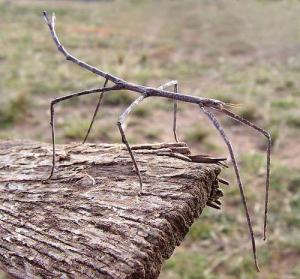Order Phasmida consists of more than 3,000 valid species and over 4,700 taxonomic names. Their geographical habitats range from Africa, America, Asia, to Europe. Maybe you remember seeing them in your backyard or at the zoo. But what you are missing out about them is so much greater than what you already know!
Common North American Walkingsticks
If you spent your childhood in North America, I am sure you remember seeing these funky, stick looking insects swaying around amongst its lookalike trees and plants either roaming in the wild or chilling in a fish tank in your second grade classroom. Phasmida, also commonly known as walkingstick or stick bug in United States, is one of the most unique insects found in our backyards.
Phasmidas are usually found in more tropical areas like Southeast Asia and South America, but it has a sizable existence in North America as well. Most North American species are found in Southeast regions, due to its more phasmida-friendly climate.
Of those species present in North America, Diapheromera femorata, also known as the common walkingstick, is most commonly found phasmida specie across North America in deciduous forests. Unlike its tropical cousins, the common walkingstick grows to be only about 3 inches and feed on various plant foliage, especially from oak and hazelnut trees. As its population grows above the stable limit, common walkingsticks can often be injurious to forest.
Phasmidas Found in Asia
Stick insects have the greatest diversity in Southeast Asia and South America because of the humidity. They are usually bigger and longer also. Several species are about or more than 19 inches long when measured with the legs stretched out.
The longest insect in the world is Phobaeticus chani, also called Chan’s megastick, is the longest insect in the world. The longest specimen is 22.32 inches long measured with the front legs fully extended which is now held in the Natural History Museum in London. Chan is the donor of the specimen. That’s why it is called the Chan’s megastick. Chan’s megastick was first described in 2008 and it was selected as one of the yearly “The Top 10 New Species” due to its most unusual or unique features.
So where can we find this amazing creature? Chan’s megastick was first discovered in the Heart Of Borneo rain forest. Rain forests in Southeast Asia provide an amazing condition on humidity and temperature for stick insects. Fun fact: Heart Of Borneo is an agreement aims to protect the biological, ecological, and cultural richness of the rain forests which were signed by Indonesia, Malaysia, and Brunei.
As we can see in the picture below, its brown exoskeletons work perfectly as a camouflage, especially they live on high tree canopies. It literally looks like a stick in a forest.
Australian Phasmidas
Australia is a big country, and it is so big that it is considered a continent! We would naturally expect phasmida to prosper in this vast lands, but that is not the case. Unfortunately, due to it’s geographical features, Australia is  not a very hospitable place for phasmida to live in. The Outback of Australia is so hot and dry that barely any insects can survive there. Thus, they usually live around the more humid and cooler areas, such as Queensland, New South Wales, and Western Australia. Moreover, phasmida is seen more often during December to February, when it is the warmest in Australia. Let’s look at this map that shows the habitats of Phasmida in Australia.
not a very hospitable place for phasmida to live in. The Outback of Australia is so hot and dry that barely any insects can survive there. Thus, they usually live around the more humid and cooler areas, such as Queensland, New South Wales, and Western Australia. Moreover, phasmida is seen more often during December to February, when it is the warmest in Australia. Let’s look at this map that shows the habitats of Phasmida in Australia.
Now why do Phasmida avoid dry, hot areas? Phasmida cannot survive in low humidity. Phasmida will harden if they do not get enough humidity. This automatically makes phasmida live in more humid areas and stay away from dry regions. Moreover, Phasmida eggs will not hatch until they are provided with enough humidity and temperature! No wonder there cannot be any cases of phasmida living in the Outback!
There are lots of different Phasmida in Australia. The most notable one is Titan Stick Insect, which is known to be the longest type of phasmida in Australia! These little buddies live around the coast, where there is enough plantation and water to survive.
These ones are called Stick Insects. They are little bit smaller than the Titan Stick insect (which you can assume from their names). They also live in the coasts and the woods where they can live without being hardened. Interestingly, the species in Australia are smaller and thinner than the Phasmids we can find in places like Malaysia. Why is this happening? This question can be answered through understanding the difference in the climates of the two regions. Australia is typically drier and less hotter in the coastal areas than in Malaysia. This makes the Phasmids shape themselves smaller so that they will be able to retain water. Also, they try to mimic their environment, and since Malaysia has a lot of forests, the phasmids in Malaysia tend to mimic the big tree leaves to protect themselves!
So, now that you know more about different species of phasmida, you can even scout out for different types of walkingsticks when you are traveling abroad!
Citations:
http://www.britannica.com/EBchecked/topic/418919/North-American-walkingstick




